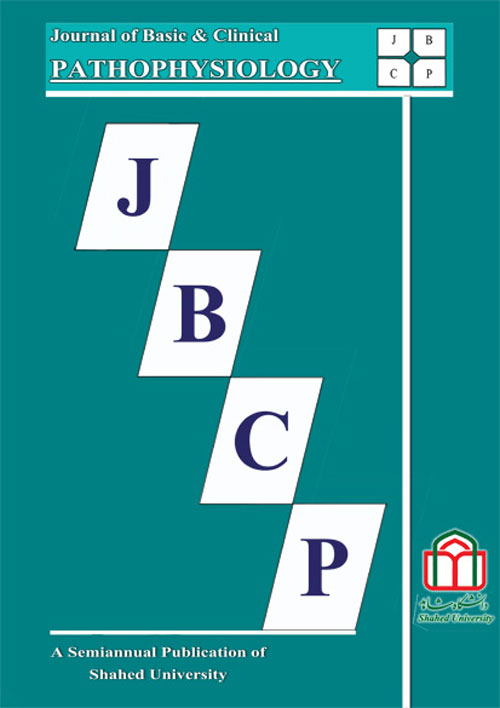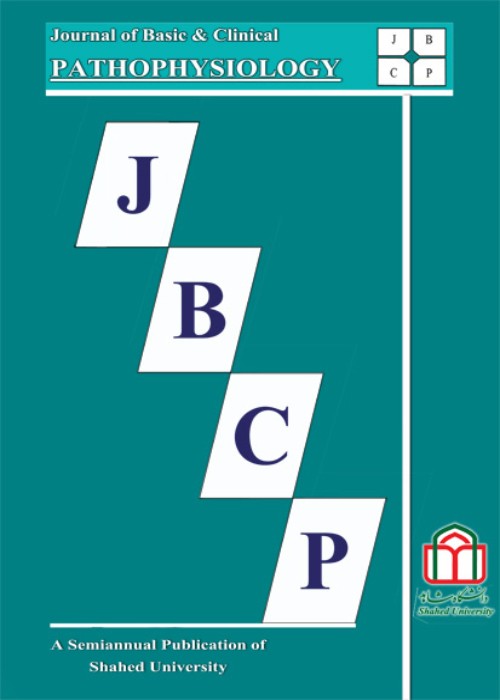فهرست مطالب

Journal of Basic & Clinical Pathophysiology
Volume:3 Issue: 2, Summer-Autumn 2015
- تاریخ انتشار: 1394/06/19
- تعداد عناوین: 8
-
-
Pages 1-4Background And ObjectiveNasal polyp is the most common benign mass of the nasal cavity and it is originated from nasal cavity or sinuses. Cytokeratins (CK) are intermediate filament proteins that provide mechanical support in epithelial cells. The purpose of this study was to compare the expression of cytokeratin 7 in epithelium of nasal polyps and nasal mucosa in chronic rhinosinusitis.Materials And MethodsThis research was a cross-sectional descriptive-analytic study. Level of expression of cytokeratin 7 in 90 samples from patients with nasal polyps and 30 samples from patient with chronic rhinosinusitis in Mostafa Khomaini hospital (Tehran, Iran) during 2007-2011 was assessed by immunohistochemistry using monoclonal antibody and Hematoxilin-Eosin staining and the results were analyzed by Mann-Whitney and t-tests.ResultsThere was significant correlation between the level of expression of cytokeratin 7 in the epithelium of nasal polyps and nasal mucosa in chronic rhnosinusitis (P)ConclusionAccording to the significant correlation for the expression levels of CK7, it seems that this biologic factor is involved in the development of nasal polyp in the presence of inflammation.Keywords: Nasal Polyp, Chronic Rhinosinusitis, Cytokeratin 7
-
Pages 5-8Background And ObjectiveParkinson''s disease (PD) is an age-related neurodegenerative disease with selective damage of dopaminergic neurons of the mesencephalon. L-dihydroxyphenylamine (L-DOPA) therapy is currently the gold standard maneuver for PD. Due to the protective, anti-inflammatory, and antioxidant effect of sesamin, this study was undertaken to assess dose-dependent effect of this agent on motor asymmetry induced by intrastriatal injection of 6-hydroxydopamine in the rat.Materials And MethodsIn this experimental research, male Wistar rats (n=48) were equally divided into sham, sesamin20-treated sham, 6-hydroxydopamine (OHDA)-lesioned, sesamin10 and sesamin20-treated lesion groups, and sesamin20-treated lesion group receiving the estrogenic antagonist fulvestrant. Model of PD was induced by microinjecting 12.5 microgram of 6-OHDA dissolved in normal saline-ascorbate solution into the left striatum. Treated lesion groups received sesamin at doses of 10 or 20 mg/kg/day started one week till 1 h before the surgery. After 1 week, ipsilateral and contralateral rotations induced by apomorphine were counted and net scores were obtained.ResultsIn the 6-OHDA-lesioned group, the dopaminergic agonist apomorphine induced contralateral rotational behavior (PConclusionSesamin administration at doses of 10 and 20 mg/kg could reduce motor asymmetry and attenuate forced biased rotational behavior in 6-OHDA-induced model of PD and part of this effect is possibly via an estrogenic pathway.Keywords: Sesamin, 6, hydroxydopamine, Rotational behavior, Motor asymmetry
-
Pages 9-12Background And ObjectivesE. coli and Klebsiella spp. are recognized as most prevalent bacteria causing urinary tract infection (UTI), the most common bacterial infection. Decreasing of antimicrobial susceptibility in urinary pathogens has made difficulty in treatment of UTI. The aim of this study was to determine antibiotic susceptibility of E. coli and Klebsiella spp. isolated from urine of patients with UTI attending a university hospital in Tehran (Iran) to guide the choice of empiric antibiotic treatment.Materials And MethodsAll midstream urine samples obtained from patients with UTI from 23 October 2012 to 20 June 2013 at Shahid Mostafa Khomeini hospital in Tehran were cultured and bacterial isolates were identified by standard methods. Susceptibility pattern of E. coli and Klebsiella spp. isolates were determined by the disk diffusion method in accordance with CLSI guideline against ampicillin, amikacin, co-amoxiclav, cephalothin, cefotaxime, ciprofloxacin, co-trimoxazole, gentamicin, tetracycline, nalidixic acid and nitrofurantoin.ResultsDuring 8 month study period, altogether 331 urine had produced positive culture, which most common isolates were E. coli (n=216) and Klebsiella spp. (n=50). E. coli showed maximum susceptibility to amikacin (97%) and nitrofurantoin (92.5%), while Klebsiella spp. isolates had shown maximum susceptibility to amikacin (95.8%) and gentamicin (83.8%). Susceptibility to ampicillin and co-amoxiclav were very low.ConclusionDecreased susceptibility to most common antibiotics in urine prevalent isolates in this study should be considered in treatment of UTI.Keywords: Urinary tract infection, Antibiotic susceptibility, Escherichia coli, Klebsiella spp
-
Pages 13-18Background And ObjectiveHyperalgesia is one of the marked clinical signs of patients with diabetes mellitus that affects their lifestyle. This study was conducted to assess the anti-nociceptive effect of chronic administration of curcumin in streptozotocin (STZ)-diabetic rats using formalin, hot tail immersion, and paw pressure tests.Materials And MethodsThis study was conducted on 40 male rats that were divided into control, curcumin-treated control, diabetic, and curcumin-treated diabetic groups. The treatment groups received i.p. administration of curcumin at a dose of 50 mg/kg for 4 weeks. Finally, hyperalgesia were assessed using standard tests. Meanwhile, serum MDA and TNFa level was also measured.ResultsCurcumin treatment of diabetic rats significantly reduced pain score in chronic phase of formalin test (p)ConclusionChronic administration of curcumin has anti-nociceptive property, partly via attenuation of lipid peroxidation and inflammatory processes.Keywords: Curcumin, Diabetes mellitus, Anti, nociceptive, Formalin test, Hot tail immersion test, Paw pressure test, Lipid peroxidation, Inflammation
-
Pages 19-24Background And ObjectiveIdentifying the details of the injurious effects of alcohol seems to be decisive in nowadays with growing abuse of the substance. This study mainly aimed to assess the adverse effects of ethanol on the recalling of information in the Wistar rats.Materials And MethodsMale Wistar rats (Pasteur Institute of Iran) were evaluated using the novelty seeking behavior based on the place conditioning task. The animals in the conditioning phase were confined in only one side of the equipment. They (n=8 per group) were intraperitoneally injected ethanol at high (1-8 g/kg) or low (0.1-0.8 g/kg) concentrations prior to the testing. The control group solely received saline solution (1 ml/kg, i.p.) in the testing day. The liver samples of the experimental animals were examined to provide the setback systemic injury evidence for the ethanol.ResultsBased on the findings, the ethanol treated rats did not remember the previous data and showed more interest to the novel side (p)ConclusionRecalling of the facts need permanent comparisons between the receiving reminiscences from environ with the information which already exist in the memory boxes. This study may show the prompt troubling influence of ethanol on the memory retrieval along with the long-lasting systemic hazard of the biggest gland.Keywords: Ethanol, Novelty seeking behavior, Information recall, Rat
-
Pages 25-28Background And ObjectiveParkinson''s disease (PD) is a movement disorder with debilitating symptoms. Available treatments for PD mainly include its symptomatic relief with no prevention of its progression. Due to the iron-chelating and antioxidant effect of phytic acid (PA), this study was conducted to assess its protective effect in 6-hydroxydopamine-induced model of PD in rat.Materials And MethodsUnilateral intrastriatal 6-OHDA-lesioned rats were daily pretreated with PA p.o. at a dose of 100 mg/kg for three days till 1 h pre-surgery. Apomorphine-induced rotations were counted at 1st week post-surgery.ResultsA significant contralateral rotational behavior was observed in 6-OHDA-lesioned rats (p)ConclusionThese findings imply that pre-lesion PA treatment could attenuate motor asymmetry in experimental model of PD and this may be of benefit in lessening motor derangements in afflicted patients.Keywords: Phytic acid, Parkinson's disease, 6, hydroxydopamine, Motor asymmetry
-
Pages 29-36Background And ObjectiveThe medicinal plant Origanum vulgare. subsp. vulgare in the Lamiaceae family has been widely used by Iranian people for the treatment of respiratory, gastrointestinal and neurologic disorders. The present study was carried out to evaluate possible anxiolytic effects of aqueous extract of O. vulgare leaves and the flowering branches in rats.Materials And MethodsAnxiolytic activity was assessed using the elevated plus-maze test. In addition, the possible sedative effect and muscle relaxant effect were evaluated using open field test and horizontal wire test, respectively.ResultsSingle doses of O. vulgare extract(50, 100 and 200 m/kg) were administered intraperitoneally in male rats. Control rats were treated with an equal volume of saline, and the positive control rats with diazepam. In the elevated plus-maze, O. vulgare extract(200 mg/kg) increased percent of time spent on open arms(pO. vulgare did not cause myorelaxant effect.ConclusionThese results suggest that the aqueous extract of O. vulgare leaves and flowers has anxiolytic effect and may also have potential sedative effects.Keywords: Origanum vulgare L, Anxiolytic effect, Elevated plus, maze test, Open field test, Horizontal wire test
-
In Vitro Evaluation of Inhibitory Effect of Artemisinin and Dihydroartemisinin on Calcineurin EnzymePages 37-42Background And ObjectiveArtimisinin (an anti-malaria drug) is extracted from Artemisia annua and its water soluble derivative is dihydroartimisinin. Previous in vivo and in vitro studies showed that it has an inhibitory effect on T cells. It is also useful for immunosuppression of immune system.Materials And MethodsThe stable state kinetic for comparison of inhibitory effect of artimisinin, dihydroartimisinin and cyclosporine A on calcineurin activation was used in this study. First, the best inhibitory concentration of artimisinin, dihydroartimisinin and cyclosporine A was calculated. Afterwards, the km and Vmax of them in the presence of substrate, paranitrophenylphosphate (P-NPP) were measured. The KI was calculated in the presence of cyclosporine A, artemisinin and dihydroartemisinin. In this study, we used distilled water instead of sample in blank and cyclosporinA as a positive control group.ResultsThe Vmax in the control group was 81.97 M/min and in the presence of cyclosporine A and artemisinin or dihydroartemisinin were 81.97 M/min and 66.225 M/min, respectively. The Km in the absence of inhibitors was 1.886 M and in the presence of cyclosporine A and artemisinin or dihydroartemisinin was 2.819 M and 1.736, respectively. Also, KI in the presence of artimisinin and dihydroartimisinin was 4.219 ×10-5 M and in the presence of cyclosporine A was 2.021×10-5 M.ConclusionThis study indicates that the inhibitory power of artimisinin and dihydroartimisinin is almost equal and they inhibited calcineurin competitively, while inhibitory effect of cyclosporine A is non-competitive.Keywords: Cyclosporine A, Artimisinin, Dihydroartimisinin, Calcineurin, Calmudulin


